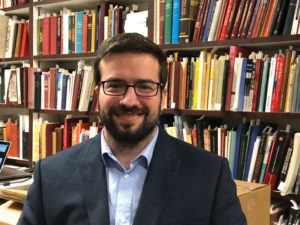
Arshak Abelyan
Staff Writer
Shortly before the beginning of the Spring 2020 semester, the Armenian Studies Program announced that Dr. Ari Şekeryan was appointed as the 16th Kazan Visiting Professor in Armenian Studies for the Spring 2020 semester at Fresno State. As part of his assignment, Dr. Şekeryan is teaching a three-unit course entitled “Armenians in the Ottoman Empire after the Genocide,” as well as giving three public lectures.
Dr. Şekeryan’s course examines the aftermath of the Genocide in the Ottoman Empire, analyzing the Armenian community in the Ottoman Empire and modern Turkey after the First World War. The course started with a survey of the history of the Armenian community in the Ottoman Empire from the 19th to the early 20th century, and how changes within the policy of the Empire affected the Armenian population over time, including significant topics such as the Ottoman Tanzimat (Reforms) in the late 19th century, the massacres that took place during Abdul Hamid II’s rule, and the Adana massacres that took place in 1909.
The course continues with an explanation of the reasons why the Ottoman Empire entered World War I and what caused the Armenian Genocide. Toward the conclusion of the course, Dr. Şekeryan will discuss the postwar agreements and how the Armenian survivors continued to live in the newly established Turkish Republic.
“I think it is important to learn about the violence in the Ottoman Empire against the Armenians during the Genocide of 1915. But it is important to study the before and aftermath of the violence, particularly the causes and the consequences of the Genocide,” said Dr. Şekeryan.
“In our course we will focus particularly on the post-Genocide period, because the historiography of the Armenian Genocide tends to only focus on the war years of 1914-1918. One must also study the significance of the Armistice years of 1918-1923.”
The course also focuses on building a strong general understanding of the violence in the Ottoman Empire such as the Hamidian Massacres in the 19th century and the Adana Massacre of 1909. Dr. Şekeryan believes that it is beneficial for students to have a general background, because if students are to enter a graduate program within this field, it will be important for them to have knowledge of late Ottoman Armenian history.
The methods that Dr. Şekeryan uses in teaching his course are based on using power-point presentations, short documentary-style videos, in-class discussions based on assigned readings, and through supplemental course readings.
In response to a question about why he chose to do research on this topic, Dr. Şekeryan touched on his great-grandfather’s genocide story. Şekeryan’s great-grandfather’s wife and three children were all taken away during the Genocide, when he was returning to his home village. He never heard from them again, however, he was adopted by a Circassian family and given the name Kara Duran. He later escaped and returned to his village in Sepastia and married the only remaining Armenian woman, who was also a survivor.
“When I learned this story in 2010, I decided to do research on the survivors of the Genocide, because my great-grandfather and great-grandmother were also survivors” said Dr. Şekeryan. “What happened after 1915? Perhaps three-fourths of the Armenian population was killed, but there were also survivors. How did they continue to live, what did they experience in Turkey, in Syria, and in Lebanon?”
While Dr. Şekeryan was attending Getronagan Armenian High School in Istanbul, teaching Armenian history was forbidden. All of the history teachers in the Armenian schools were appointed by the government. While taking courses in Ottoman history and language at Bogaziçi University for his MA degree, he also began volunteering at Aras Publishing. There he began to learn Armenian history, to speak Armenian with colleagues, and to read Ottoman and Armenian newspapers.
During the few months that Dr. Şekeryan has been in Fresno, he has become familiar with the Armenian community. “I really felt like I was at home when I met Armenians, visited the Saroyan House Museum, and churches. Even at a restaurant, I feel like I’m back home. It’s the same people, food, and language,” concludes Dr. Şekeryan.
 Hye Sharzhoom Armenian Action
Hye Sharzhoom Armenian Action